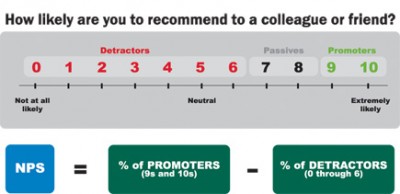They describe Net Promoter Score (NPS) as The Ultimate Question:
How likely is it that you would recommend this Club/Studio/Class/Instructor to a friend or colleague?
As a Life Time Fitness Instructor/employee I hear about our NPS scores frequently... and if you don't understand what NPS refers to and the effect it could have on their business or your class, you may be thinking; "so what?"
Well the short answer is your NPS score is an indication of how likely your students will be to promote the club where you teach or your class to their friends.
Let's start with some understanding from the people who developed this concept:
What is Net Promoter?
Net Promoter® is both a loyalty metric and a discipline for using customer feedback to fuel profitable growth in your business. Developed by Satmetrix, Bain & Company, and Fred Reichheld, the concept was first popularized through Reichheld's book The Ultimate Question, and has since been embraced by leading companies worldwide as the standard for measuring and improving customer loyalty.The Net Promoter Score, or NPS®, is a straightforward metric that holds companies and employees accountable for how they treat customers. It has gained popularity thanks to its simplicity and its linkage to profitable growth. Employees at all levels of the organization understand it, opening the door to customer- centric change and improved performance.
As you can see in the image above, NPS is based on a 0-10 rating score in response to the question; How likely is it that you would recommend to a friend or colleague? The responses are then broken down into three categories:
- 0-6 Detractors - Unhappy people who will talk down your class or club - damaging your brand through negative word of mouth.
- 7-8 Passives - Satisfied, but won't go out of their way to promote your class to others.
- 9-10 Promoters - these are your fans 🙂 The students you look forward to seeing and they in turn look forward to telling others about the awesome class you just taught. In a nut shell, these are the people who will help FILL YOUR CLASS!
To calculate the NPS you subtract the number of Detractors from Promoters, which leaves you with either a positive number (good), zero, or a negative number (bad). So if you have 100 people respond to a survey of the ultimate question if you have more Promoters than Detractors you can expect to see your class size grow.
NPS ignores the Passives as they really don't hurt or help your business. I see the real improvements coming from moving the Detractors up the scale.
I have a few personal complaints and/or concerns with NPS:
- The score tends to be skewed by the number of respondents and getting busy people to respond is tough... which is why your manager is forever asking you to ask your participants to complete a survey.
- I'm personally more inclined to give negative feedback, actually... I'm guessing we all are.
- You may have very little influence on your clubs NPS. If your bike maintenance is lacking, one of the two projectors isn't working or the locker room has a funny smell that causes a member to score your club as a Detractor, there isn't much you can do. This could be a good reason to drill down and solicit NPS for specific areas/departments.
So beyond Life Time, who else uses NPS to measure how successfully they are satisfying their customers? Apple for one. The link is to an article that dispels the myth that Steve Jobs never listened to his customers - Apple listens every day.
In Podcast # 196 Studio Owner Emmy Ragali explains why she has an Instructor Evaluation form on her Go Cycle website. The link to it is easy to find and she and her instructors encourage participants to give feedback regularly. I see that one of the questions is; Are you likely to recommend this instructor's class to a friend?
Which is really all that matters 🙂
Does your studio use NPS [wlm_firstname]? What have been your experiences?
I'll be discussing how we all can help to improve our clubs NPS scores in later articles.


not sure if the 2 clubs I coach in have this but will be sure to ask about it.
The old adage, ‘the squeaky wheel gets the grease’ is hugely at play in the fitness club world.
Like Renee, I’m not sure if the clubs at which I ply the trade do the NPS.
Regardless, we do have comment cards and no shortage of members with the hutzpah to complain. My observation is that most of the members are in the 7 – 8 range and don’t ever say much of anything. They’re more likely to just leave if not happy.
Although the promoters are talking to their friends and that is good, the detractors are talking to management. Therefore they have a more direct influence.
Question: What do you think has more impact on club management, reading a Net Promoter Score off a piece of paper or listening to a complaining member?
And since it is rare for the raving fan to approach management and proclaim how great we are, the fact is that just one or two ‘difficult’ members can skew managements view much more than comparing numbers.
So even considering John’s wariness, I would vote for NPS at the facilities where I am teaching. Used correctly this sort of data provides a far better picture for club management than a squeaky wheel that doesn’t like virtual rides or pop or techno or drills…
John/Amy, this could make a good podcast for the, ‘teaching at the big box’ fitness club.